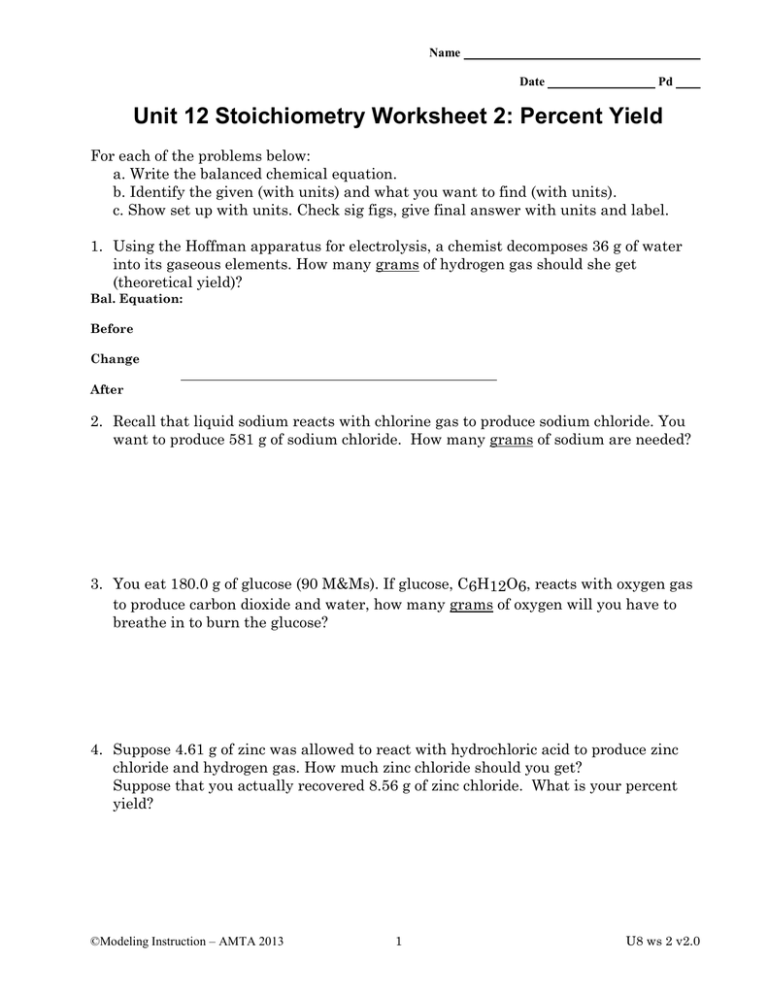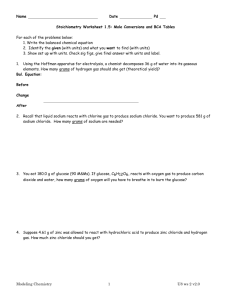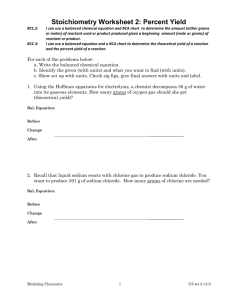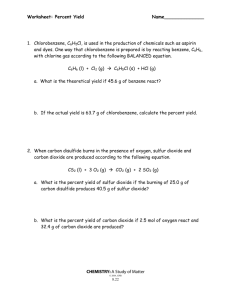Stoichiometry Percent Yield Worksheet: High School Chemistry
advertisement

Name Date Pd Unit 12 Stoichiometry Worksheet 2: Percent Yield For each of the problems below: a. Write the balanced chemical equation. b. Identify the given (with units) and what you want to find (with units). c. Show set up with units. Check sig figs, give final answer with units and label. 1. Using the Hoffman apparatus for electrolysis, a chemist decomposes 36 g of water into its gaseous elements. How many grams of hydrogen gas should she get (theoretical yield)? Bal. Equation: Before Change After 2. Recall that liquid sodium reacts with chlorine gas to produce sodium chloride. You want to produce 581 g of sodium chloride. How many grams of sodium are needed? 3. You eat 180.0 g of glucose (90 M&Ms). If glucose, C6H12O6, reacts with oxygen gas to produce carbon dioxide and water, how many grams of oxygen will you have to breathe in to burn the glucose? 4. Suppose 4.61 g of zinc was allowed to react with hydrochloric acid to produce zinc chloride and hydrogen gas. How much zinc chloride should you get? Suppose that you actually recovered 8.56 g of zinc chloride. What is your percent yield? ©Modeling Instruction – AMTA 2013 1 U8 ws 2 v2.0 5. Determine the mass of carbon dioxide that should be produced in the reaction between 3.74 g of carbon and excess O2. What is the % yield if 11.34 g of CO2 is recovered? 6. In the reaction between excess K(s) and 4.28 g of O2(g), potassium oxide is formed . What mass would you expect to form (theoretical yield)? If 17.36 g of K2O is actually produced, what is the percent yield? 7. Determine the mass of carbon dioxide one could expect to form (and the percent yield) for the reaction between excess CH4 and 11.6 g of O2 if 5.38 g of carbon dioxide gas is produced along with some water vapor. 8. Determine the mass of water vapor you would expect to form (and the percent yield) in the reaction between 15.8 g of NH3 and excess oxygen to produce water and nitric oxide (NO). The mass of water actually formed is 21.8 g. Check your answers (1) 4.0 g H2 (5) 13.73 g CO2, 82.6% (2) 228 g Na (6) 25.3 g K2O, 68.8% ©Modeling Instruction – AMTA 2013 2 (3) 192 g O2 (4) 9.61 g Zn, 89.1% (7) 7.99 CO2, 67.4% (8) 25.1 g H2O, 86.9% U8 ws 2 v2.0







